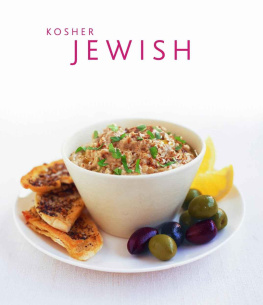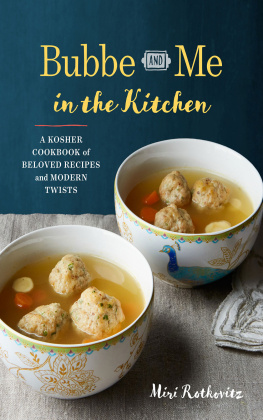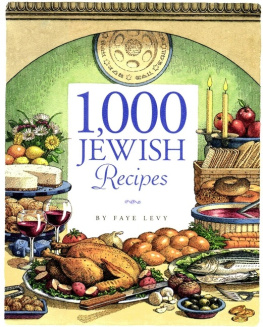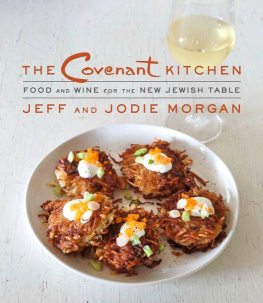| Kosher and Traditional Jewish Cooking: Authentic Recipes From a Classic Culinary Heritage: 130 Delicious Dishes Shown in 220 Stunning Photographs |
| Number I of Cookbook 2007 |
| Marlena Spieler |
| Lorenz Books (2007) |
|
| Rating: |
- Discover the secrets of the Jewish kitchen with this beautiful new cookbook, featuring 130 fantastic, authentic recipes.
- Everything you need to know: background to the culinary history of the Jewish people, its food rules and laws, and all about the special equipment, ingredients and cooking techniques.
- Ever-popular dishes include dips and appetizers such as Baba Ghanoush, Herring Salad with Beetroot and Sour Cream, fish and meat dishes such as Ginger Fishballs in Tomato and Preserved Lemon Sauce and Jerusalem Barbecued Lamb Kebabs, salads such as Tabbouleh, breads such as New York Seeded Corn Rye Sourdough, and desserts such as Polish Apple Cake.
KOSHER AND TRADITIONAL
JEWISH
COOKING
KOSHER AND TRADITIONAL
JEWISH
COOKING
AUTHENTIC RECIPES FROM A CLASSIC CULINARY HERITAGE: 130 DELICIOUS DISHES SHOWN IN 220 STUNNING PHOTOGRAPHS
Marlena Spieler
Contents
Introduction
Jewish food: the phrase conjures up images of borscht, chicken soup with matzo balls, salt beef and chopped liver. These certainly are Jewish foods, relished by generations of Eastern European Jews, but Jewish cuisine is much, much more varied than that.
I grew up in California. The foods we ate were those of West Coast America artichokes and oranges and avocados but our culinary souls were also nourished by the foods of the Old Country of our grandparents era: kasha , gedempte flaiche and knaidlach , matzo brei and kishke from Ashkenazi Russia, Poland, the Ukraine and Lithuania, all served with a delicious overlay of Old New York.
Jewish food is a combination of richly varied cuisines from all over the globe, reflecting the multi-ethnicity of the Jewish people, and the many places where they have settled over the course of time. For years I thought the little savoury pastries called empanadas were typically Jewish, because thats what my cousin used to make when we visited her. It was only years later that I discovered they were native to Uruguay, where she was raised.
In the past, the Ashkenazim and Sephardim were often far removed from each other; the spicy food of the Sephardim was seldom served on traditional Ashkenazi tables and vice versa. The establishment of the State of Israel, migration and the expansion of modern travel have changed this considerably, and brought Jews together again, starting at the table where they can share their own flavours and dishes.
Regardless of where history has taken them, the food Jews eat is governed by the laws of Kashrut the code of fitness that applies to what may be eaten, how food must be prepared and which foods can be combined with other foods. There are variations in how different ethnic groups adhere to Kashrut, and degrees of observance, but the basics are the same. Certain types of meat, fish and fowl are allowed, while others are forbidden. Rules govern the slaughter and inspection of animals, as well as which parts may be used, and there is an injunction against combining meat foods with dairy foods. This set of rules has kept the Jewish people culturally distinct, as well as giving an underlying flavour to their food.
Kofta kebabs are very popular in Jewish communities from the Middle East.
Fragrant beetroot (beet) and vegetable soup with spiced lamb kubbeh.
The preparation, eating and rituals involved with Kashrut have always played an important part in the lives of the Jewish people. In the Torah, the Patriarch Abraham is noted for the hospitable table he sets. It is recorded that Isaac asked his son for a nice dish of savoury meat, and also that Esau sold his birthright for a big, soupy lentil stew. In Chapter 11 of the book of Numbers, the story is told of how the Israelites fleeing Egypt wept with longing for the garlic and leeks they had eaten during their captivity even freedom lacked flavour without delicious seasonings.
Filo-wrapped fish best served with a zesty tomato sauce.
The noted Andalucian-Egyptian philosopher and physician Moses Maimonides (Moses ben Maimon) emphasized the importance of serenity of spirit, both for cook and diner. He also stressed the value of eating healthy food, prepared appealingly. Sharing sociable meals, he suggested, not only made for a happier, less anxious individual; it also bridged the differences between ethnic groups.
Fried matzo meal and cottage cheese latkes.
When Jews gather together, we eat, and what we eat are often the traditional foods, because each food has its own story. The flavour of remembrance seasons all our meals as we recall where we have wandered and who we met along the way, the meals we shared and the ingredients that filled our pots along each mile, in every place.
In this book I would like to share with you my favourite recipes from various Jewish communities throughout the world, and from my own life and traditions as well. In the words of the Hebrew expression that translates as bon appetit , I wish you all Btay avon .
Marlena Spieler
Soups, appetizers and brunch
From chopped liver to aubergine (eggplant) salads, Jewish appetizers are adored by everyone. Festive meals from the weekly Shabbat to annual holidays almost always include a selection of appetizers and what often distinguishes an everyday meal from a celebration is the serving of these delicacies.





















